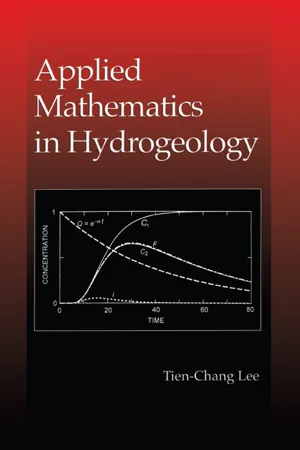
- 400 pages
- English
- ePUB (mobile friendly)
- Available on iOS & Android
eBook - ePub
Applied Mathematics in Hydrogeology
About this book
As introduced in Dr. Lee's 10-week class, Applied Mathematics in Hydrogeology is written for professionals and graduate students who have a keen interest in the application of mathematics in hydrogeology.
Its first seven chapters cover analytical solutions for problems commonly encountered in the study of quantitative hydrogeology, while the final three chapters focus on solving linear simultaneous equations, finite element analysis, and inversion for parameter determination.
Dr. Lee provides various equation-solving methods that are of interest to hydrogeologists, geophysicists, soil scientists, and civil engineers, as well as applied physicists and mathematicians. In the classroom, this same information will help students realize how familiar equations in hydrogeology are derived-an important step toward development of a student's own mathematical models.
Unlike other applied mathematics books that are structured according to systematic methodology, Applied Mathematics in Hydrogeology emphasizes equation-solving methods according to topics. Hydrogeological problems and governing differential equations are introduced, including hydraulic responses to pumping in confined and unconfined aquifers, as well as transport of heat and solute in flowing groundwater.
Frequently asked questions
Yes, you can cancel anytime from the Subscription tab in your account settings on the Perlego website. Your subscription will stay active until the end of your current billing period. Learn how to cancel your subscription.
No, books cannot be downloaded as external files, such as PDFs, for use outside of Perlego. However, you can download books within the Perlego app for offline reading on mobile or tablet. Learn more here.
Perlego offers two plans: Essential and Complete
- Essential is ideal for learners and professionals who enjoy exploring a wide range of subjects. Access the Essential Library with 800,000+ trusted titles and best-sellers across business, personal growth, and the humanities. Includes unlimited reading time and Standard Read Aloud voice.
- Complete: Perfect for advanced learners and researchers needing full, unrestricted access. Unlock 1.4M+ books across hundreds of subjects, including academic and specialized titles. The Complete Plan also includes advanced features like Premium Read Aloud and Research Assistant.
We are an online textbook subscription service, where you can get access to an entire online library for less than the price of a single book per month. With over 1 million books across 1000+ topics, we’ve got you covered! Learn more here.
Look out for the read-aloud symbol on your next book to see if you can listen to it. The read-aloud tool reads text aloud for you, highlighting the text as it is being read. You can pause it, speed it up and slow it down. Learn more here.
Yes! You can use the Perlego app on both iOS or Android devices to read anytime, anywhere — even offline. Perfect for commutes or when you’re on the go.
Please note we cannot support devices running on iOS 13 and Android 7 or earlier. Learn more about using the app.
Please note we cannot support devices running on iOS 13 and Android 7 or earlier. Learn more about using the app.
Yes, you can access Applied Mathematics in Hydrogeology by Tien-Chang Lee in PDF and/or ePUB format, as well as other popular books in Technology & Engineering & Applied Mathematics. We have over one million books available in our catalogue for you to explore.
Information
Chapter 1
CONSERVATION EQUATIONS
Heat transfer, fluid flow, and solute transport are governed by the principles of conservation of energy, momentum, and mass. Mathematically, these conservation principles, together with empirical laws, can be expressed as a set of partial differential equations. Subject to initial and boundary conditions as well as appropriate source functions, the equations can be solved analytically or numerically to interpret observations or predict certain phenomena.
In this chapter we will show how seemingly different physical processes can be modeled by differential equations that have the same functional forms. We will attempt to derive each equation with a different method.
1.1 Heat Conduction
1.1.1 Heat Energy
Heat flux is the rate of heat energy transferred through a unit area across the transport path. It is a vector and has a dimension of energy per unit area per unit time, [W m−2]. The heat flux can be conductive (diffusive), convective, or radiative. In this section, we consider heat conduction problems only.
Let the positive x-coordinate be in the direction of heat flux. Given heat flux q at location x in a one-dimensional continuum, the heat flux at neighboring location x + Δx is,

Figure 1.1: Heat flux qx+Δx at x + Δx as extrapolated by the Taylor series from qx at x, i.e., qx+Δx ≈ qx + (∂q/∂x)Δx.
(1.1) |
which follows the first-order Taylor theorem (Figure 1.1). This relation means that if a functional value qx and its slope ∂qx/∂x at x are given, the functional value qx+Δx at x + Δx can be extrapolated from the given value by following the slope to the desired location.
If qx+Δx > qx, the material in the space between x + Δx and x loses energy by the amount of ΔE per unit volume over time interval Δt. This energy change is accompanied by temperature change ΔT. The two changes are empirically related by
(1.2) |
where the proportional constant ρcv is ...
Table of contents
- Cover
- Title Page
- Copyright Page
- Dedication
- Table of Contents
- PREFACE
- 1 CONSERVATION EQUATIONS
- 2 SOURCE FUNCTIONS AND CONVOLUTION
- 3 LAPLACE AND HANKEL TRANSFORMS
- 4 DRAWDOWN IN CONFINED AQUIFERS
- 5 DRAWDOWN IN UNCONFINED AQUIFERS
- 6 HEAT TRANSFER AND GROUNDWATER FLOW
- 7 SOLUTE TRANSPORT
- 8 SOLVING Ax = b
- 9 FINITE ELEMENT ANALYSIS
- 10 INVERSE PROBLEMS
- Appendix: Notes on Equation Solving
- BIBLIOGRAPHY
- INDEX